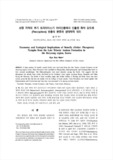

PARTNER
검증된 파트너 제휴사 자료
보령 지역의 후기 트라이아스기 아미산층에서 산출된 화석 강도래(Plecoptera) 유충의 분류와 생태학적 의미 (Taxonomy and Ecological Implications of Stonefly (Order: Plecoptera) Nymphs from the Late Triassic Amisan Formation in the Boryeong region, Korea)
10 페이지
최초등록일 2025.03.13
최종저작일
2017.08

-
서지정보
· 발행기관 : 한국지구과학회
· 수록지 정보 : 한국지구과학회지 / 38권 / 4호 / 293 ~ 302페이지
· 저자명 : 남기수
초록
최근 보령 지역의 후기 트라이아스기 아미산층에서 다량의 화석 강도래 유충이 발견되었다. 이들의 유충은 그형태적 특징에 의해 Platyperlidae과, Baleyopterygidae과, Siberioperlidae과 등으로 분류되었다. 이 중 양적으로 가장 많이 발견되는 종류는 Baleyopterygidae과의 화석 강도래이다. 이러한 사실은 강도래가 러시아, 몽골 및 중국을 비롯한 동북아시아 지역까지 이미 중생대부터 넓게 분포했음을 의미한다. 현생 강도래는 대부분 유수성이며 맑은 물에 서식하기때문에 화석 강도래가 발견되는 보령 지역도 유사한 환경이었을 것으로 추정된다. 또한 강도래와 함께 발견되는 화석들로 미루어 볼 때 당시의 강도래는 하루살이나 패갑류 등을 먹고 살았던 것으로 추정된다.영어초록
A large number of stonefly nymph fossils were discovered from the Late Triassic Amisan Formation in the Boryeong region, Korea. These Plecoptera were classified as Platyperlidae, Baleyopterygidae, and Siberioperlidae based on their external morphologies. The Baleyopterygidae were most abundant among the fossils. This suggests that the plecopteran has already been widely distributed in the Northeast Asian region including Russia, Mongolia and China during the Mesozoic. The fossils of these stoneflies imply that benthic habitats of flowing and fresh waters may have existed, given the fact that they are similar with the biology of extant species. These Plecoptera were found together with Ephemeroptera and Conchostraca and thus, they were presumed to be preying on these insects.참고자료
· 없음태그
-
자주묻는질문의 답변을 확인해 주세요

꼭 알아주세요
-
자료의 정보 및 내용의 진실성에 대하여 해피캠퍼스는 보증하지 않으며, 해당 정보 및 게시물 저작권과 기타 법적 책임은 자료 등록자에게 있습니다.
자료 및 게시물 내용의 불법적 이용, 무단 전재∙배포는 금지되어 있습니다.
저작권침해, 명예훼손 등 분쟁 요소 발견 시 고객센터의 저작권침해 신고센터를 이용해 주시기 바랍니다. -
해피캠퍼스는 구매자와 판매자 모두가 만족하는 서비스가 되도록 노력하고 있으며, 아래의 4가지 자료환불 조건을 꼭 확인해주시기 바랍니다.
파일오류 중복자료 저작권 없음 설명과 실제 내용 불일치 파일의 다운로드가 제대로 되지 않거나 파일형식에 맞는 프로그램으로 정상 작동하지 않는 경우 다른 자료와 70% 이상 내용이 일치하는 경우 (중복임을 확인할 수 있는 근거 필요함) 인터넷의 다른 사이트, 연구기관, 학교, 서적 등의 자료를 도용한 경우 자료의 설명과 실제 자료의 내용이 일치하지 않는 경우
찾으시던 자료가 아닌가요?
지금 보는 자료와 연관되어 있어요!
문서 초안을 생성해주는 EasyAI



